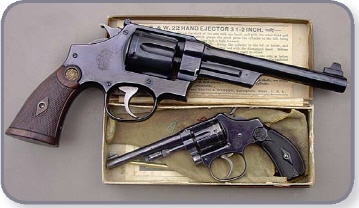
Chapter V
EARLY HAND EJECTORS
(NAMED MODEL REVOLVERS, 1896 - 1957)
CONTENTS
Note: Many early Hand Ejector models are continued after 1957 as Numbered Models. These Numbered Models are listed in the next section of this book.
This section is generally organized by caliber, then frame size, then chronologically within frame size.
• M Frame .22s -Ladysmith 1st, 2nd, and 3rd Models
— Bekeart and .22/32 Target Models
Experimental small- to medium-caliber revolvers
• .30 Caliber M-1 Carbine N Frame
— .32 HE 1st Model (Mod. 1896),
Models of 1903 (2nd), 3rd Models
— .32 Regulation Police Models
• .32-20 Hand Ejectors 1st Model
.38 S&W and .38 S&W Special Caliber
— .38 Military & Police 1st Mod. (Mod. 1899)
— .38 Military & Police Victory Model
• I Frame .38 S&W (continued as J frames)
— .38 Regulation Police Models
• .44 Hand Ejector: 1st (Triple Lock), 2nd, 3rd (1926), and 4th (1950) fixed-sight and Target Models
• .45 Hand Ejector U.S. Model 1917
• .455 Mark II Hand Ejector 1st and 2nd Models

Target Triple Lock with Ladysmith. ArmchairGunShow.com photo
Notes:
• Where the same model was made in more than one caliber, it is listed under the caliber most commonly encountered.
• Many of these guns were continued as numbered models (see next section). Collectors of post-war named models may also want to read the introductory material at the beginning of the Numbered Model Revolvers section, as some of it also applies to these named models.
• Most I frame models were continued as Improved I frames and then J frames.
• Basic characteristics:
— Solid framed revolvers with swing out cylinders.
— No model number designated on the frame
under the yoke (open cylinder and look at
left side of frame under rear of barrel).
— Made prior to 1957, when S&W began
giving each model a number.
EARLY HAND EJECTOR BACKGROUND INFORMATION
The Hand Ejector is the style of handgun that epitomizes S&W to the world.
Just as the concept of revolvers firing self-contained metallic cartridges had a rather anemic beginning with the Model One, the S&W Hand Ejector (HE) line was launched with the slightly awkward 1896 First Model .32 Hand Ejector. By 1899, however, the first K frame .38 caliber Smith &Wesson Hand Ejector was made. It became the revolver that would define the police handgun for the next 100 years.
Another 19th century S&W pattern that would be repeated in the 20th was that of developing new cartridges that would dramatically expand handgun capabilities. Early S&W-developed cartridges such as the .32 S&W, .38 S&W and .44 Russian were eventually eclipsed by the cartridges developed for the Hand Ejectors: .38 Special, .44 Special, .357 Magnum, and the .44 Magnum.
Collectors of Hand Ejectors will be alternately delighted and frustrated by the many variations. While there is a brisk and sometimes pricey market for the largest and smallest, the big N frames and tiny Ladysmiths, a collector who wishes to enjoy the hobby without mortgaging the house may find the opportunity in the early .32 and .38 I, J and K frames. Please note that many of the various changes in these models are differentiated only by fairly subtle internal modifications and serial number range.
As you use this section, please remember that many of these models were continued after 1957 when S&W began assigning model numbers to all its products. To get the complete picture on a particular variation, it may be helpful to check the information on its numbered model successor listed in the next section.
.22 CALIBER
M FRAME .22s
(THE ORIGINAL LADYSMITHS) BACKGROUND INFORMATION
The smallest Hand Ejectors ever made by S&W, these tiny guns are loved by collectors. The Ladysmith is the only gun made on the smallest Hand Ejector frame, designated the M frame. These seven-shot .22s should not be fired with modern ammunition.
An old story that has circulated for many decades concerns the discontinuance of the model. It seems that Mr. Wesson was shocked to learn that this was the gun of choice for ladies of the evening. Being of a stern Yankee puritanical bent, he ordered the production ended. True story? Probably not, since he died in 1906 and the gun was continued in production until 1921 and most probably was ended by his son. But it’s good enough that if it isn’t true, it should be.
COLLECTOR’S TIP
Do not confuse these with the LadySmith line of modern firearms currently manufactured by S&W. Ladysmith was just too good a name to let die, and has been applied to selected current models along with subtle design modifications to reach the women’s handgun buying market. The old M frames are generally written a small “s” thus: Ladysmith, while the more recent women’s market guns have the S capitalized: LadySmith. The original designation of the Ladysmith Models would be Model 22 Hand Ejector (First, Second or Third Model). The series is also referred to as Model M Hand Ejector or Model 22 Perfected Three models are listed below. Total of 26,152 manufactured c. 1902 – 1921.
.22 Ladysmith 1st Model
Caliber: .22 Long, double action revolver built on the round butt M frame, 2-1/4", 3" or 3-1/2" barrel lengths (we have observed a box factory labeled for a 2" barrel, as well as what appears to be an original factory barrel – not attached to a gun – measuring just under 2"), checkered hard rubber grips. A frame-mounted cylinder release is found on the left side, blue or nickel finish, pinned barrel, 7-shot fluted cylinder with a nominal length of .975"; round blade front sight with a notch cut rear sight in the top strap. Weight is 9.5 oz. Serial number range 1 - 4575 manufactured c. 1902 – 1906.
ID Key: 7-shot, tiny M frame, round butt, small round cylinder release button on side of the frame.
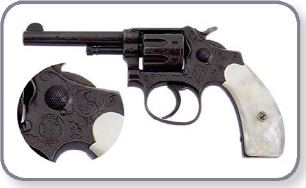
Engraved 1st Model Ladysmith. Note cylinder release button. David Carroll collection, Paul Goodwin photo.

AUCTION BLOCK
1st Ladysmith, factory engraved, medallion pearl grips, “excellent to fine” - $14,560 – Greg Martin Auctions, June 2002.
Variations
• Significant premium for original barrels shorter than 3".
.22 Ladysmith 2nd Model
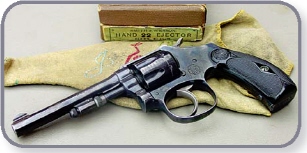
2nd Model Ladysmith. ArmchairGunShow.com photo.
Caliber: .22 Long, double-action revolver built on the round butt M frame, 3” or 3-1/2” barrel lengths; changes include the cylinder locking device being placed on the barrel bottom with a knurled knob and removed from the frame’s left side. 7-shot fluted cylinder with a nominal length of .975”. Blue or nickel finish, pinned round barrel, fixed sights consisting of a forged round blade front sight with a notch cut in the top strap for a rear sight. A few were made with target sights. Black hard rubber grips on a round butt frame; also found with pearl or ivory grips. No cylinder release button on the side of the frame; the cylinder opens by pulling on front end of ejector rod under the barrel. A small S&W trademark is found on the frame’s left side. Serial number range 4576 - 13950 with 9374 manufactured c. 1906 – 1910.
ID Key: 7-shot, tiny M frame, round butt, no cylinder release button.

.22 Ladysmith 3rd Model (.22 Perfected)
Caliber: .22 Long. Double-action revolver built on the square butt M frame with 5 screws, 2-1/4” (rare), 3”, 3-1/2” or 6” barrel lengths, plain smooth walnut grips with gold S&W medallions on a square butt design frame; blue or nickel finish, .180” checked rebounding hammer, smooth trigger, pinned round barrel, 7-shot fluted cylinder with a nominal length of .975”. Target versions have 6” barrels with a pinned Paine front sight on a raised boss and rear sight adjustable for windage and elevation. Matching serial numbers are found on the butt, cylinder, behind the star extractor, on the face of the yoke and the barrel bottom. Target models also have the serial number under the rear sight leaf.
Patent dates of Aug. 4, 1896; Oct. 8, 1901, Nov. 10, 1903; and Sept. 14, 1909 marked on the top of the barrel. Barrel is marked “.22 S&W CTG.” Cylinder opens as the previous model by pulling forward on the rod. This model has a four-screw sideplate with a trigger guard screw. A small S&W trademark is found on the sideplate or the frame. Weight for a 3” model is 10 oz. Serial number range 13951 - 26154 with 12,203 manufactured c. 1911 – 1921.
ID Key: 7-shot, tiny M frame, square butt.
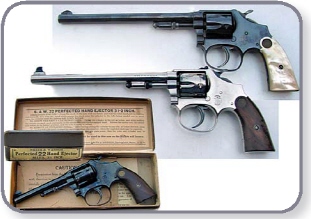
3rd Model Ladysmiths. Rare fixed sight 6" barrel top; scarce target sight 6" barrel middle; standard configuration in box bottom. ArmsBid.com photos.

PRICE CHECK
Club Gun 3rd Ladysmith, serial number 0, “fine…90%”, listed at $2,950 – Old Town Station Dispatch, 2004.
Variations:
• 6" barrel with target sights: Double to triple
AUCTION BLOCK
3rd Ladysmith, 6" target, “excellent to fine…98%” - $4,200 – Greg Martin Auctions, June 2002.
• 6" barrel with fixed sights: Triple plus
AUCTION BLOCK
3rd Ladysmith, 6” fixed sights, nickel, “excellent to fine…95%” -$4,500 Greg Martin Auction, June 2002.
• 10 inch barrel variation known to have been produced.
• Original 2-1/4" barrel rare, worth significant premium.
AUCTION BLOCK
Two 2.25” barreled 3rd Model Ladysmiths sold – one “excellent plus, checkered ivory medallion grips” - $9,900; the other a 2.25” target sighted gun not confirmed by factory with extensive factory rework marks, “excellent as reworked” - $6,875 - Supica’s Old Town Station, Oct. 2003.
Three 6” barreled 3rd Model Ladysmiths sold – one fixed sights, medallion pearls, “excellent factory refinished” - $1,540; one target sights, “excellent” - $2,420; the last target sights, “fine to excellent”
- $2,200 – same auction as above.
I AND J FRAME .22s
BACKGROUND INFORMATION
S&W distributor Phil Bekeart is credited with originating the concept of a .22 caliber revolver on a .32 Hand Ejector frame. Prior to that, S&W .22 revolvers had been tiny guns – either the Model One tip-up or the M-frame Ladysmith. Probably the best known and loved member of this family is the Kit Gun, so named as an ideal size and caliber to pack along on a fishing or camping trip in the tackle kit.
.22/32 Hand Ejector (.22/.32 Bekeart Model or .22/.32 Heavy Frame Target)
Caliber: .22 Long Rifle. Double-action revolver built on the .32 Hand Ejector I frame with a 6-shot fluted cylinder having a nominal length of 1.25”. 6” round pinned barrel, blue finish, adjustable rear sights for windage and elevation, 5-screw round butt frame with checkered walnut extension type grips; .240” smooth trigger with .240” checked hammer. The front sight is a thin blade (either 1/10" or 1/8") with a bead top pinned in a raised boss, flat faced hammer with floating firing pin, knurled round end extractor rod. A small S&W trademark is found on the left side of the frame below the thumbpiece.
This model is named after San Francisco dealer Philip Bekeart who originally contracted S&W to manufacture this revolver. A full discussion of the origins of this model can be found in Roy Jinks’ article in the Journal of the SWCA, reprinted beginning at page 158 of Book 1 of the 25th Anniversary edition.
Our first edition doubtless contributed to some confusion as to what constitutes a “True Bekeart.” To try to straighten this out, we’d like to suggest that there are probably at least four levels of “Bekeartness” which can claim to be “True Bekearts.” Ranked from “Truest” to “Still sorta true” Bekeart, these are:
1) First Bekeart Shipment: Most desirable are the 292 guns contained in the first shipment which went to Bekeart in 1911. Serial numbers for this shipment can be found in the Jinks article listed above. Boxes marked for Philip Bekeart are rare.
2) First Bekeart-Pattern Production Run: When the Bekeart order was received, S&W made 1,044 .22- caliber target sighted revolvers on the .32 frame with target extension grips, although this was not introduced as a cataloged model. The guns included in the First Bekeart Shipment were in this production run, but many of the others went to other dealers. These fall in the serial number range of 138226 to 139275 in the .32 HE serial number series.
3) Bekeart Grip Numbered Revolvers: A distinguishing feature of the first production run was a separate serial number stamped in the bottom of the wood grips. This began with “1.” This was continued on Bekeart pattern revolvers produced after the initial production run, up through “3000.”
4) Bekeart-shipped .22/32 HEs from later production: A case could certainly be made that any pre-war .22/.32 that letters as shipped to Bekeart could be considered a “True Bekeart.”
In 1915, the Bekeart Model was introduced as a regular cataloged model, the .22/.32 Heavy Frame Target Model, at about serial number 160000 (in the .32 HE Mod. 1903 5th change series). The Bekeart Model has the rear sight elevation screw threaded into the frame, while those on later target models are threaded into the rear leaf, with a T slot cut in the frame much as on today’s production. Cylinder chambers recessed for the case head began in 1935 – reportedly at serial number 525600 – but collectors report recessed chambers as low as 384570. The serial number is viewed on the forestrap without grip removal. Weight is 23 ounces and the guns were made c. 1911 – 1941.
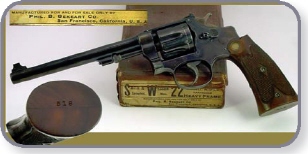
True Bekeart, with numbered grips and scarce Bekeart marked box. ArmsBid.com photo.
ID Key: I frame, .22 caliber, square butt, serial number on front strap, serial number range, 6 inch barrel, extension stocks.

PRICE CHECK
.22/.32 Target New York master engraved, ivories, “100% factory refinish,” listed at $3,150 – David Carroll, 2006.
.22/.32 Target, Gough engraved, “80-90%”, listed at $1,950 – ArmchairGunShow.com, 2006.
.22/.32 Target, Roper grips, “95-97%”, listed at $1,250 – Old Town Station Dispatch, 2005.
Variations
• First Bekeart Shipment: worth two times to three times standard values.
• First Production Run (but not Bekeart shipped): Add 50 - 100%.
• Early Bekeart numbered grips, but not first production run: Add 25 - 75%.
• Bekeart shipped (but not first shipment): Add 10 - 50%.
.22/.32 Target Model
(Postwar Or Transitional)
Caliber: .22 Long Rifle. The authors have not been able to confirm the existence of a “Transitional” Model postwar .22/.32 Target Hand Ejector. If they exist, we expect them to be similar to the above, with the addition of the hammer safety block, in the serial number range of 551123 - 590000. They would not have the features introduced in the successor model, the 1953 .22/.32 Target listed below. Knowledgeable collectors say they exist.
Model of 1953 .22/32 Target
(“Pre-Model 35”)
Caliber: .22 Long Rifle. Double-action revolver now built on the improved I frame with a hammer safety block and coil mainspring that deleted the strain screw and also the trigger guard screw. Features a 6” pinned barrel with a serrated top rib, blue finish, micrometer click rear sight, 1/10” Patridge front sight, 6-shot fluted cylinder with a nominal length of 1.25”, walnut grips with diamond insert, flat latch thumbpiece in the three variations. This post-war model is now built on the improved I frame with four screws or three screws and later the J frame circa 1961 and has a smooth backstrap and forestrap. Although it is reported that the upper sideplate screw was deleted early in the serial range (1955: reported as serial number 11000), many four-screw frames are found in higher serial numbers. Serial range 101 - 135465 in the original 1953 Kit Gun series produced c. 1953 – 1969.
ID Key: Similar to above with improved I frame, 6” barrel, serial number range.

Production Changes
• 1953: Introduced as “Improved I Frame” with hammer block (deletes trigger guard screw and strain screw).
• 1955: Deletion of upper sideplate screw authorized.
• 1957: Continued as the Model 35 (see next section)
.22/.32 Kit Gun (Prewar)
Caliber: .22 Long Rifle. Double-action revolver built on the round butt I frame with 5 screws, 6-shot fluted cylinder with a nominal length of 1.25”, 4” round pinned barrel, blue or nickel finish, round butt frame with either round or extension type square butt grips, checkered walnut grips with S&W monograms and diamond inserts, 1/10” Patridge or a U.S.R.A. pocket revolver front sight with an adjustable rear sight for windage and elevation, heat-treated cylinder with recessed head chambers. Originally built on the 32 Hand Ejector I frame. A small S&W trademark is found on the frame’s left side. Weight: 21 oz.
Serial number range 525670 - 536684 in the .32 Hand Ejector series manufactured c. 1935 – 1941.
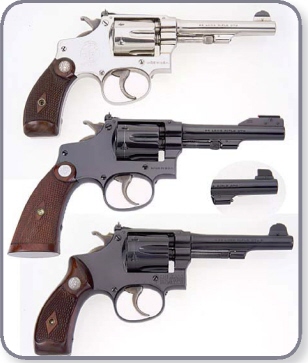
Kit guns, top to bottom: Rare nickel; square butt with King front sight (USRA front sight, inset); scarce Transitional. Tom Horwedel collection; Paul Goodwin photo.
ID Key: I frame .22 with round butt, 4” barrel, serial number range.

Variation
Substantial premium for nickel.
AUCTION BLOCK
Pre-war Kit Gun, in red box, “excellent…99%” - $2,310 – Supica’s Old Town Station, Oct. 2003.
PRICE CHECK
Pre-war Kit Gun, “97-98%”, listed at $2,500 – David Carroll, 2006.
Pre-war Kit Gun, engraved by Vern Wagoner, round butt “98%”, listed at $2,850 – ibid.
.22/32 Kit Gun (Postwar or Transitional)
Caliber: .22 Long Rifle. Double-action revolver built on the round butt I frame with five screws, 4” barrel, blue or nickel finish, 6-shot fluted cylinder with a nominal length of 1.26”, 1/10” Patridge or USRA pocket revolver front sight with adjustable micrometer click rear sight for windage and elevation, stocks are checkered walnut with S&W monograms or small square butt or special target stocks. Initial postwar production identical to prewar, except for serial number range and the new slide action hammer block. It is speculative that they were also built on the Improved I frame with four screws. Serial number range beginning 536685 – c. 590000 within the .32 Hand Ejector series. Produced c. 1946 – 1952.
ID Key: As above, except hammer block and serial number range.

Variations
• Original 2" barrel scarce, worth premium.
Note: A general discussion of post-WWII “Transitional Models” can be found at the beginning of the .38 N Frame listings of this book.
Model of 1953 .22/32 Kit Gun “Pre-Model 34”
Caliber: .22 Long Rifle. Double-action revolver built on an improved I frame with a hammer safety block and coil mainspring which deleted the strain screw and also the trigger guard screw. Features a 2” or 4” pinned barrel with a narrow top rib, 6-shot fluted cylinder with a nominal length of 1.25”. The 2” barrel has what appears to be a high profile 1/10” serrated ramp front sight (actually this is the same height as the 4” barrel version and has a micrometer click rear sight). .312” serrated trigger that was later changed to a smooth trigger, .375” checked semi-target hammer, blue or nickel finish. The flat latch thumbpiece is found in the three variations; walnut grips with a diamond around the screw escutcheon. Built on the improved I frame with four screws or three screws with round or square butt frame and later on the three screw J frame c. 1961. Smooth backstrap and forestrap. A small S&W trademark is found on the frame’s left side. Two-inch versions with fixed sights are known to exist as a training gun. The serial number is found on the butt, cylinder face, yoke, right grip panel and barrel flat. Although it is reported that the upper sideplate screw was deleted early in the serial range (1955; reported as 11000), many four screw frames are found in the higher serial numbers. Serial range 101 - 135465 in the original 1953 22/32 Kit Gun series produced c. 1953 – 1969.
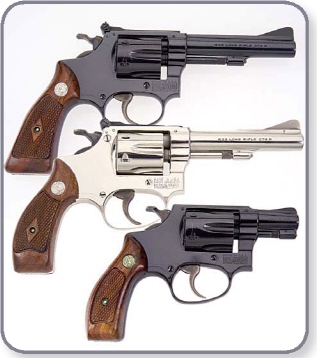
Post-war Kit Guns: 4” square butt; 4” nickel round butt; 2” fixed sight round butt. Tom Horwedel collection. Paul Goodwin photos.
ID Key: Similar to above, except improved I frame or J frame and serial number range

Production Changes
• 1953: Introduced as improved I frame (deletes trigger guard screw and strain screw).
• 1955: Deletion of upper sideplate screw authorized.
• 1957: Continued as the Model 34 (see next section).
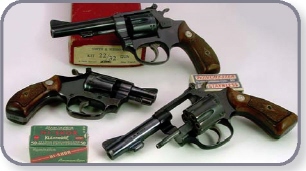
Kit guns: 4” round butt and 2” round butt standard steel frame Kit Guns, with a 4” square butt Airweight Kit gun. Armsbid.com photo.
1955 .22/32 Kit Gun Airweight – “Pre-Model 43”
Caliber: .22 Long Rifle. Double-action revolver built on the square butt aluminum alloy J target frame with three screws and aluminum alloy 6-shot fluted and counterbored cylinder with a nominal length of 1.44”. Features a 3-1/2” barrel with rare 2” versions known to exist, 1/10” serrated ramp front sight with micrometer click rear sight. Four-screw frames are not thought to exist since no known examples have been found or reported, (examination of frame serial number 5009 reveals it to be a three screw frame). Blue finish (factory nickel scarce but known to exist), narrow serrated top rib on a pinned barrel, walnut grips with diamond around the screw escutcheon, .260” serrated trigger with .360” checked hammer. The flat latch thumbpiece is found in three versions. Smooth backstrap and forestrap. A small S&W trademark is on the frame’s left side; this Model, unlike other Airweights, is not “Airweight” marked on the barrel. Also found chambered in .22 WMR in limited production with nickel or blue finish (rare; the authors recommend verification before purchase on a gun chambered in 22 WMR). The serial number is found on the butt, cylinder face, yoke, right grip panel and barrel flat. Original serial number range 5000 - 135465 in the 1953 Kit Gun series produced c. 1954 – 1974.

Production Changes
• 1957: Continued as the Model 43 (see next section).
Variations
• 2" barreled version serial number 25724 shipped to D. B. Wesson III (great-grandson of D.B. Wesson), February 13, 1957.
• Original nickel triple premium, if confirmed by factory letter.
• Original 2" barrel double premium, if confirmed by factory letter.
K FRAME .22
BACKGROUND INFORMATION
There have been three main concepts driving the manufacture of K frame .22s:
1) They make an ideal outdoorsman’s small game hunting or plinking revolver.
2) For the first half of the 20th century, K frame revolvers dominated traditional bullseye target shooting. The K frame .22 Target models made ideal companions to the K-32 and K-38 revolvers.
3) K frame .22s make ideal training guns for police officers or other individuals whose carry gun is a .38- caliber K frame. The low cost of .22 ammunition, along with its milder report and recoil, allow for more training rounds.
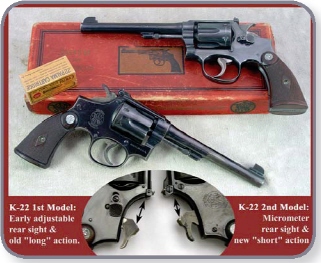
K-22 1st and 2nd Models. Note differences in sights and old long action vs. new short action. Old Town Station photo.
Model K-22 Outdoorsman
(K-22 1st Model)
Caliber: .22 Long Rifle, double action revolver built on the square butt K frame with five screws, 6-shot fluted cylinder with counterbores, blue finish or nickel finish (special order). 6” round pinned barrel with no rib, Patridge front sight, K target frame with a floating firing pin and flat faced hammer, Circassian walnut grips with small silver medallions on a square butt frame, non-shrouded extractor rod, smooth semi-round topstrap with an adjustable rear sight for windage and elevation. Built on the .38 Hand Ejector frame and numbered within the M&P 1905 4th change series in a serial range beginning 632124 and running through about 682419. The first example of this revolver was presented to Douglas Wesson on January 3, 1931, reported as serial number 632132. Weight of this model is 35.5 oz. 19,500 manufactured c. 1931 – 1940.
ID Key: K frame .22, pre-micrometer adjustable sights, long action.

AUCTION BLOCK
K-22, 1st with box, “excellent plus…99%” - $1,128 – Supica’s Old Town Station, Oct. 2003.
PRICE CHECK
K-22, 1st, humpback, “95%”, listed at $2,250 – Lyle Larkworthy, GunsAmerica.com, 2006.
K-22, 1st with box and related accessories, “99+%”, listed at $1,875 – David Carroll, 2006.
Variations
• Coast Guard Issue: Twenty-five with service sights shipped to the Coast Guard at Curtis Bay, MD, in 1935 in a serial range of 650929 - 650953. May bring as much as 10 times standard value or more.
AUCTION BLOCK
Fixed sight K-22 1st Model, “good…50% thin blue” - $6,095 – James D. Julia Auction, March 2003.
• Earliest production had only one screw holding on the rear sight.
• A small quantity was shipped to the U.S. Army for use in the 1932 Olympics.
Model K-22 Masterpiece
(Prewar, K-22 2nd Model):
Caliber: .22 Long Rifle. Double-action revolver built on the square butt K target frame with five screws, blue finish or nickel (special order). 6” round pinned barrel with no rib, diamond walnut grips with small silver medallion or diamond walnut Magnas on a square butt frame, short cocking action with anti-backlash trigger, 6-shot counterbored and fluted cylinder with a nominal length of 1.6”. The micrometer click rear sight was first introduced on this model; front sight is 1/8” or 1/10” plain Patridge, Call gold, or plain bead. A large S&W trademark is found on the sideplate. Features which distinguish this K-22 2nd Model from the K-22 First Model include the taller rear sight mechanism and the short action hammer (with visible “frame stop notch” on hammer body behind and below hammer spur). Serial number range among the 1905 4th Change M&P series in a range of 682404 - 696952 with 1067 manufactured c. 1940 - 1941. See Neal and Jinks for specific serial numbers.
ID Key: K target frame .22, micrometer click adjustable sights, short action, no barrel rib.

AUCTION BLOCK
K-22, 2nd, “Excellent…98%” - $3,450 – Rock Island Auction, April 2006.
K-22, 2nd, “as new…about 100%” – $4,290 - Supica’s Old Town Station, Oct. 2003.
PRICE CHECK
K-22, 2nd, “98+%”, listed at $5,000 – David Carroll, 2006.
Model K-22 Masterpiece
(Postwar, 3rd Model) – “Pre-Model 17”
Caliber: .22 Long Rifle. Double-action revolver built on the square butt K target frame with five screws and 6-shot fluted cylinder with a nominal length of 1.6”. Similar to the K-22 Masterpiece 2nd model with early production having a narrow serrated top rib with a slight taper on the barrel, later changing to a full width serrated rib with no taper. This model was the beginning of the K serial prefix range at K101. 1/10” or 1/8” plain Patridge front sight. Rear sight is a micrometer click for windage and elevation. Standard blue finish, made with the post war slide action hammer block, checkered walnut stocks with S&W monograms and diamond around the screw escutcheon. Has 6-groove forestrap and backstrap on the frame. The hammer is checked and is .375” wide with a .265” wide serrated trigger with an adjustable stop. Serials numbers are found on the butt of the frame, cylinder face, yoke, behind the star extractor and on the barrel flat. “Smith & Wesson” is on the barrel’s left side, with “22 Long Rifle CTG” on the right side. A large S&W trademark is found on the side plate. Pre-1948/ post-1946 frames can be found with just “Made in U.S.A.” Beginning in 1948 the frame was stamped with the four address lines and is found on the frame’s right side above the trigger guard. Serial range K101, to the end of the K series and starting over again with the three-letter serial prefix. Many examples are found with a hole drilled in the frame under the grips, possibly to accommodate a lanyard pin. See also the Model 17 made c. 1946 – 1989.
ID Key: Similar to the 2nd model, with a ribbed barrel.

Production Changes
1952: Delete 1/10” Patridge Front Sight.
1955: Delete Upper Sideplate Screw.
1957: K-22 Masterpiece Continued As Model 17 (see next section on model numbered Hand Ejectors).
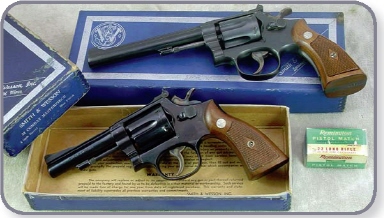
K-22 Masterpiece (top) and K-22 Combat Masterpiece. ArmchairGunShow.com photo.
The K-22 Combat Masterpiece – “Pre-Model 18”
Caliber: .22 Long Rifle. Double-action revolver built on the square butt K target frame with five screws, 4” pinned barrel, blue finish (nickel scarce), combat style 1/8” Baughman Quick Draw on plain ramp base front sight, micrometer click adjustable rear sight, short action, walnut grips with diamond around the screw escutcheon, four-line “Made in USA” address. Counterbored 6-shot fluted cylinder with a nominal length of 1.6”, narrow serrated rib on the barrel, target hammer, target trigger, K serial prefix, 6-groove serrated backstrap and forestrap. Produced c. 1949 – 1985.
ID Key: As above, with 4” barrel.

Variations
• Nickel guns that letter as factory worth about double blued value.
Production Changes
• 1955: Delete upper sideplate screw; change to 10-groove tangs.
• 1957: Continued as the Model 18 (see next section).
The .22 Military And Police
(“Post Office Model”) – “Pre-Model 45”
Caliber: .22 Long Rifle. Double action revolver built on the square butt K frame with five screws. Designated as a training gun for the U.S. Postal Service, the only K frame produced in .22 LR without target sights (other than special orders – the 1935 Coast Guard K-22 Outdoorsman order, for example). Blue finish, 6-shot counterbored cylinder with a nominal length of 1.6”, serrated trigger, checked hammer spur, 4” round pinned barrel, round blade front sight or serrated ramp with square notch rear; serial numbered concurrently with the Model 10, 11, and 12 in the M&P series. A listing of the serial numbers of 150 guns from a 1958 shipment to the Post Office (described as Model 10s in .22 caliber) can be found in the SWCA Journal, 25th Anniv. reprint, Book 2, pg. 342. Not cataloged by S&W. Produced c. 1948 – 1978.
ID Key: .22 K frame with fixed sights.

AUCTION BLOCK
.22 M&P, “New in box” – one for $2,588 and another for $2,070 - Rock Island Auction, April 2006
Variations
• Boston P.D.: 20 units shipped in April 1957 to Boston Police Dept. Boston, Mass. with 6” barrel with blue finish with Magna walnut stocks and marked “B.P.D.” with number on the smooth backstrap. One example is C379431.
• New York P.D.: Reported that a small quantity with 4” barrels shipped to the NYPD.
Production Changes
• 1948: Introduction at serial S982000.
• 1948-1957: Serial range prefix changed to “C” in a range of C1 to approximately C407527.
• 1957: Continued as the Model 45 (see next section).
COLLECTOR’S TIP
Models chambered in .22 Long Rifle were continued after 1957 and are listed in the next section, “Numbered Model Revolvers.”
• Model K-22 Masterpiece (see Model 17).
• Model K-22 Combat Masterpiece (see Model 18).
• Model of 1953 .22/32 Kit Gun (see Model 34).
• Model of 1953 .22/32 Target (see Model 35).
• Model of 1955 .22/32 Kit Gun Airweight (see Model 43).
• Military & Police .22 Heavy Barrel (Post Office Model: Model 45).
EXPERIMENTAL SMALL TO MEDIUM CALIBER REVOLVERS
.22 Hornet Caliber Experimental Revolver
Caliber: .22 Hornet. Double-action revolver built on an alloy N target frame. At least one test revolver (X-156) was made in 1955 on an alloy N frame chambered in .22 Hornet, with an alloy barrel 8-3/8” long fitted with a steel .22 caliber rifled insert. This barrel is marked X157 as its serial number. The first test cylinder was reported as alloy and factory notes indicate that it failed upon the first test firing. The second cylinder was steel and further test results are vague; however this handgun still remains fully intact, bearing the number “4” stamped in the yoke cut. There is a short record from William Gunn’s notebook to indicate that it is one of 12 or so alloy N frames made. Another frame numbered X157 is configured with a fixed rear sight and is numbered “10” in the yoke cut. The barrel marking is “S&W .22 Magnum” rather than .22 Hornet as would be expected. The gun is fitted with a target hammer and target trigger and a pinned Patridge on a ramp base front sight with the micrometer click rear sight. The authors must say this handgun example is rather impressive to hold, to examine, and to try t “quantify that which is not readily quantifiable” about this most unusual revolver and the history of what we believe to be the 12 N-frame alloy revolvers.
Other .22 Hornet test revolvers were reported by S&W factory historian Roy Jinks as being made on the 547 frame, but reports of severe flame cutting prevented any from passing a 2000-round test, and production is not in the near future. Still other records in the Connecticut Valley Museum indicate several .22 Hornet N frames were made. N-frame .22 Hornet Cylinders have been found coming from the model shop but other complete guns are not as yet reported. Also see the .38/44 alloy N frame.
Model K-.256
Winchester Test Revolver
Caliber: .256 Winchester. Double-action revolver built on the K target and N target frames. Made as a test gun in the trials between the .22 Centerfire Magnum (Jet) cartridge and the standard .256 Winchester cartridge, this is essentially a K-22 frame with a cylinder chambered for this cartridge. Serial number K438857 (which was shipped to Winchester) has a non shrouded 8-3/8” barrel with markings of “.256 Winchester CTG.” Built on a four-screw K frame; six were built as prototypes c. 1960 using the same length cylinder as the Model 53, which is 1.67”. This example also has a standard hammer and trigger with a trigger stop. In 2000 an example chambered in .256 Winchester that was built on an N frame (X-182) came up for auction at Devines in New Hampshire; this gun, serial number X-182, sold for $5500 on Aug 27, 2000. No K frame sales have been reported.
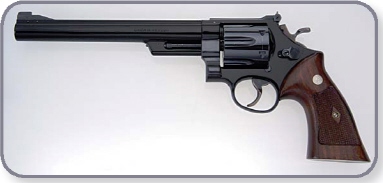
.22 Hornet experimental. Nahas collection, Paul Goodwin photo.
.30 Caliber Carbine Test Revolver
Caliber: .30 M1 Carbine. Double action revolver built on the N target frame with five screws. S&W did produce, on a test basis, several revolvers with fixed and target sights and chambered in .30 Carbine that were built on the N frame. Some of these were submitted to the Army for evaluation and tested on Jan. 17, 1944. These revolvers passed an endurance test with no breakages, but shooters objected to the severe muzzle blast and the Army did not see a military requirement for further purchase. The military report also states that the shooters did not wear hearing protection. In this case it is apparent that muzzle blast would be excessive. Recoil was reported to be about that of a .45 ACP round fired from a revolver. Average velocity from a 5” revolver barrel was 1277 fps.
At least three examples are known to still exist in private collections. Serial number 4 is of a prewar target configuration with a cylinder length of 1.6” long using half moon clips when needed. It has a barrel 5” long with a Patridge front sight and prewar features with post-war grips on a frame with a 6-groove backstrap and forestrap. In 2003 serial number 2 was auctioned by James D. Julia in October of that year. Reports are that this and two others were ordered by General “Hap” Arnold; further details are unknown. Serial number S270729 is of a postwar target configuration built on a three-screw frame with a cylinder numbered X25. A very few were also reportedly built on the M&P K frame, which proved too light for this cartridge. Spare cylinders are reported coming from the model shop but barrels or other complete guns are not as yet reported. Records in the National Archives about this revolver are scarce, but research is still ongoing by Charles Pate.
Any of these revolvers is extremely rare among collectors and would probably bring in the low five figures.
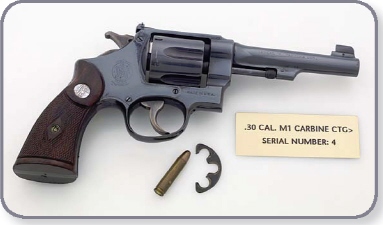
.30 Carbine test revolver. Photo courtesy of Gary Keithly.
9mm Caliber Test Revolver
Caliber: 9mm Parabellum. Double-action revolver built on the N frame. A small number of test revolvers were built on a prewar N frame. Serial number 3 and possibly serial numbers 6 and 9 were made on a test basis for the Chinese government in June of 1945. Originally requested to be in 8mm Mauser, S&W did not have an 8mm reamer but instead supplied a sample chambered in 9mm. Due to the timing of delivery and the end of the war, this sample was never delivered due to a delay in the baggage of the Army captain given the duty to deliver this gun to the Chinese. Serial number 3 as an example is fitted on the prewar N frame with a nominal cylinder length of 1.54” and a barrel length of 5”. The grips are smooth walnut without the S&W medallions. Also fitted with a lanyard swivel on the butt. The right grip panel is serial numbered to the frame as is the cylinder, rear of the star extractor, barrel, but not the yoke.
It is built with a five-screw frame with the S&W trademark on the sideplate and “Made in U.S.A.” and has a serrated trigger and checked hammer. The barrel is marked “9 M.M. CTG.” on the right side with “Smith & Wesson” on the left side.
This rare 1940s vintage prototype should not be confused with the production 9mm revolvers that were regular cataloged items in later decades. You will find those listed in the Numbered Model Revolver section under Models 547 and 940. No sales reported.
.32 CALIBER
The I frame (and later the J frame) is considered the traditional size for S&W .32-caliber revolvers. Like the .22, .32s were also made on K frames for those who preferred a larger handgun. In the early 20th century, the .32 S&W saw considerable service as a police round but later came to be considered insufficiently powerful for this purpose. Its mild recoil led many to promote it as a good chambering for a “lady’s gun.” The round enjoyed some popularity in compact self-defense revolvers, but the advent of the J frame .38 Special reduced this usage. The .32 S&W cartridge has waned in popularity as the 20th century progressed.
This has a couple of ramifications for collectors. First, .32 caliber S&Ws can sometimes be picked up at bargain prices, simply because consumer preferences run to .22 rimfires for cheap practice and plinking or .38 Special as a minimum defensive caliber. Secondly, several later variations introduced in .32 caliber were not particularly popular and accordingly saw limited production, resulting in rare and valuable models.
Target Models: Most .32 Hand Ejectors were issued with fixed sights. When one of these is found with factory original adjustable sights it will bring a premium. This will range from 25 to 50% in the lower grades to triple, quadruple or more in the higher grades.
COLLECTOR’S TIP
This is a good field in which to look for sleepers.
I AND J FRAME .32s
Model 1896 Background Information
This is the first S&W solid frame revolver with a swing-out cylinder – the Hand Ejector configuration that continues even today as the backbone of the S&W product line. It also is the first S&W Hand Ejector purchased by a police department, with 169 units going to the Jersey City, NJ, police, marked “JCP” on the backstrap. Also, guns will be found marked “Newark Police” on the backstrap.
Other interesting features on this key evolutionary model include the method of opening the cylinder by pulling on the end of the ejector rod, and the cylinder stop mounted on the top of the frame (a throwback to the old tip-up designs) rather than in the bottom of the frame as in all subsequent Hand Ejector models. Also, the patent dates are marked on the cylinder rather than on the top of the barrel. It was also the first S&W made with a circular trigger guard integral to the frame rather than as a separate piece. Finally, this marked the debut of the .32 S&W Long cartridge.
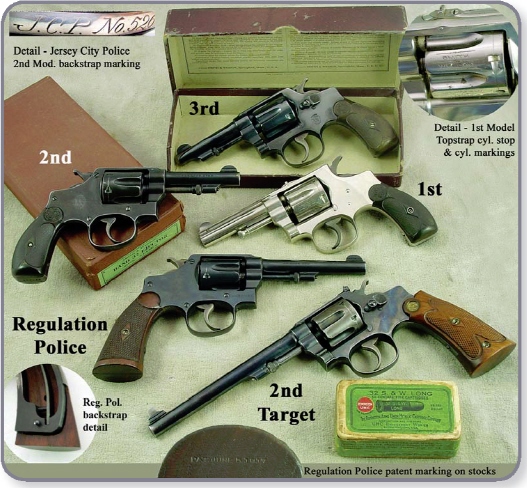
.32 Hand Ejector I frame models. ArmsBid.com photo.
.32 Hand Ejector 1st Model Double Action Revolver (Model 1 or Model 1896)
Caliber: .32 S&W Long. Double-action revolver built on the I frame. This was S&W’s first swing-out cylinder revolver or “Hand Ejector.” Its cylinder is unlocked by pulling forward on the extractor rod. Two styles of extractor rod are found. 3-1/4”, 4-1/4” or 6” barrel lengths are found. Blue or nickel finish, round butt or extension type square buttstock of black hard rubber with the S&W monogram. This model has no locking lug under the barrel and has no thumb latch. 6-shot fluted cylinder with a nominal length of 1.25”, pinned round blade front sight while the rear service sight was pinned forward in the topstrap above the cylinder. Target sights (rare) are a square cut front blade, with the rear being adjustable patent dates are stamped on the cylinder between the flutes: “May 21, 95; July 16, 95; March 27, 94; May 29, 94; July 1, 84; April 9, 89.” Four-screw sideplate with an additional screw above the trigger guard forward of the sideplate to retain the yoke. The cylinder stop is in the top strap rather in the frame. The yoke has a spring loaded plunger to assist holding the cylinder fully open and fully closed. The mainspring is a single piece leaf with a second leaf spring for the trigger return. The S&W monogram is stamped on the sideplate. Most examples have no barrel markings.
This model became the basis for the I frame. Serial numbers are located on the face of the cylinder, barrel flat and butt of the frame. The right hand grip usually has serial number scratched in or marked with chalk or pencil. Serial range of this model is very similar to that of the 2nd model. Serial number range 1 - 19712 with all 19,712 manufactured c. 1896 - 1903.
ID Key: .32 Hand Ejector with patents on cylinder and cylinder stop on topstrap. No thumbpiece, no locking lug.

Variations
• Short hammer police model worth slight premium.
• JCP (Jersey City Police) or Newark marked police guns worth premium. One example (serial number 8740) is marked “Newark Police No 168” on the backstrap. “Philadelphia PD” marked guns reported.
• Target model rare, worth premium.
.32 Hand Ejector Model Of 1903
(.32 Hand Ejector, 2nd Model)
Caliber: .32 S&W Long. Double-action revolver built on the round butt I frame; 3-1/2”, 4-1/4” or 6” round barrel lengths, blue or nickel finish, round butt or extension type square buttstock of checkered black hard rubber with S&W monograms. Service or target sights, round blade front sight forged into the barrel. This is the first model to have a locking lug for the extractor rod under the barrel and also appears to be the first model with a pinned barrel. The cylinder stop is also moved to the center of the bottom strap of the frame from the top strap, 6-shot fluted cylinder with a nominal length of 1.25”, with S&W trademark stamped on the sideplate. Serial range is similar to the first model. Serial number range 1 - 19425 with all 19,425 manufactured c. 1903 - 1904.
I.D. Key: Serial range with thumbpiece and locking lug distinguishes this from the 1st model.

Variation
• Target model worth perhaps as much as five times premium.
.32 Hand Ejector Model of 1903 – 1st Change
Caliber: .32 S&W Long. Double-action revolver built on the round butt I frame with five screws; 3-1/4”, 4-1/4” or 6” round pinned barrel lengths, blue or nickel finish, black hard rubber stocks, service or target sights (the target version had extension stocks of black rubber or walnut with an adjustable rear sight, designed like the first model with minor changes). 6-shot fluted cylinder with a nominal length of 1.25”. A small S&W monogram is stamped on the left frame side. At about serial number 48000 the hammer nose rivet was changed from solid to hollow with flared ends. Serial number range 19426 -51126 with 31,700 manufactured c. 1904 – 1906.

Variation
• Target model worth premium.
.32 Hand Ejector Model of 1903 – 2nd Change
Caliber: .32 S&W Long. Double-action revolver built on the round butt I frame with five screws, 3-1/4”, 4-1/4” or 6” round pinned barrel lengths with “32 Long CTG” on the left side, with the right side usually being observed as blank, designed like the First Change model with minor changes. A small S&W monogram is found on the frame under the thumbpiece with no other frame markings observed; patent dates are found on the top of the barrel of “March 27 1894, August 4, 1896, December 22, 1896, October 8, 1901, December 17, 1901, February 8, 1906.” Available in blue or nickel finish, with either service or target sights, black rubber stocks or walnut extension type stocks on the target version, 6-shot fluted cylinder with a nominal length of 1.25”. Target sights consist of a pin on a raised boss in the front, adjustable for windage and elevation on the rear, while the service sights are a forged round blade front sight with a notch cut rear sight. Serial numbers are located on the butt, cylinder face, yoke, barrel flat and back of the star extractor. Checked hammer and smooth trigger. Weight is 18.5 oz with a 4-1/4” barrel.
Serial number range 51127 - 95500 with 44,373 manufactured c. 1906 – 1909.

Variations
• Target model worth premium.
.32 Hand Ejector Model of 1903 – 3rd Change
Caliber: .32 S&W Long. Double-action revolver built on the round butt I frame with five screws; 3-1/4”, 4-1/4” or 6” round barrel lengths, designed like the 2nd Change version with minor internal changes. Service or target sights were available. .240” smooth trigger with a .240” checked hammer spur. Patent dates of “March 27 1894, August 4, 1896, December 22, 1896, October 8, 1901, December 17, 1901, February 8, 1906” are found on the top of the barrel. The authors have confirmed a patent date of “Feb. 6, 06” on the rebound slide. The S&W trademark is found on the frame’s left side. Identical in external appearance to the 2nd Change model. Blue or nickel finish, pinned round barrel, 6-shot fluted cylinder with a nominal length of 1.25”. A barrel marking of “32 Long CTG” is observed on the left side with the right side blank. Serial numbers are observed on the barrel flat, cylinder face, yoke, and frame. Serial number range 95501 - 96125 with 624 manufactured c. 1909 – 1910.

Variations
• Target model worth premium.
.32 Hand Ejector Model of 1903 – 4th Change
Caliber: .32 S&W Long. Double-action revolver built on the round butt I frame with five screws; 3-1/4”, 4-1/4” or 6” round barrel lengths, designed like the 3rd Change version with very minor internal changes and identical in external appearance. Blue or nickel finish, pinned barrel, 6-shot fluted cylinder with a nominal length of 1.25”. “32 Long CTG” is found on the barrel’s left side. Serial number range 96126 - 102500 with 6,374 manufactured c. 1910.

Variations
• Target model worth premium.
.32 Hand Ejector Model of 1903 – 5th Change
Caliber: .32 S&W Long. Double-action revolver built on the round butt I frame with five screws; 3-1/4”, 4-1/4” or 6” pinned round barrel lengths. Designed like the 4th Change version with major internal changes in the trigger, hammer and sear, two-piece extractor rod, blue or nickel finish, service or target sights. A small S&W trademark is found on the left side of the frame, with a few having the trademark on the sideplate. 6-shot fluted cylinder with a nominal length of 1.25” and two extractor locator pins. Serial number range 102501 – c. 263000 with about 160,499 manufactured c. 1910 – 1917.

PRICE CHECK
Factory Oscar Young engraved, presentation inscribed, medallion pearls, “95%”, listed at $3,150 – David Carroll, 2006.
Variations
• Target model worth premium.
.32 Hand Ejector Third Model
Caliber: .32 S&W Long. Double-action revolver built on the round butt I frame with five screws; 3-1/4”, 4-1/4” or 6”round barrel lengths, blue or nickel finish, 6-shot cylinder with a nominal length of 1.25”, service sights with round blade front sight, a new hammer block arm was introduced on this model. Heat-treated cylinders began in 1920 with serial 321000. Identical in external appearance to Model of 1903, Fifth Change. Serial number found on the butt, cylinder and barrel. A small S&W trademark is found on the left side of the frame. .240” smooth trigger, .240” checked hammer spur. Some early examples did not have the four-line address marking on the frame. Walnut wood grips with a diamond around the screw escutcheon have been observed as well as black rubber stocks. The rubber stocks all had the S&W monogram while all the wood stocks had the monogram missing. Barrel markings are “Smith & Wesson” on the right side with “32 Long CTG” on the left side. Identical in appearance to the 1903, 5th Change model. Serial numbered concurrently with the .32 Regulation Police. One examined box was the one-piece with hinged lid design, dark purple in color with a patent date of Dec. 20, 1920, numbered to serial number 438605. Serial range 263001 - 536684 with 271,531 manufactured c. 1917 – 1942.

Variations
• Target model worth premium.
The .32 Hand Ejector (Postwar) – Pre-Model 30
Caliber: .32 S&W Long. Double-action revolver built on the round butt I frame with five screws, or the improved I frame with four screws. It is reported that the upper sideplate screw was deleted in 1956 at serial number 640980; examples are found in upper serial ranges with the fourth screw. Similar to the 3rd Model with postwar improvements: new style rebound hammer block and a change in the extractor rod. 6-shot fluted cylinder with a nominal length of 1.25”, blue or nickel finish; 3-1/4”, 4-1/4” or 6” barrel lengths (2” also observed), 1/10” round blade front sight with square notch rear sight, checkered walnut stocks with S&W monograms. .240” smooth or serrated trigger, .240” checked hammer spur. Normal production thumbpiece is observed until production of the J frame, at which time the thumbpiece was changed to the flat latch. Barrel markings are “.32 S&W CTG” on the right with “Smith & Wesson” on the left side. A small S&W trademark is found on the frame under the thumbpiece. Serial numbered concurrently with the .32 Regulation Police. Became the Model 30 in 1957. Serial range 536685 - 712953 made c. 1946 – 1960.
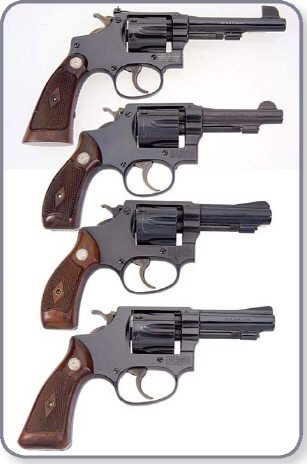
.32 Hand Ejectors: Regulation Police Target top, pre- and post-war HEs middle; post-war Regulation Police bottom. From Paul Goodwin photos.

Production Changes
• 1948: Postwar production with 3-1/4”, 4-1/4” and 6” barrel.
• 1949: Introduce 2” barrel.
• 1953: Improved I Frame (deletes trigger guard screw and leaf style mainspring with strain screw).
• 1956: Eliminate upper sideplate screw at approximately serial number 640980.
• 1957: .32 Hand Ejector continued as the Model 30 (see next section).
.32 Regulation Police (Pre-War)
Caliber: .32 S&W Long. Double-action revolver built on the square butt I frame with five screws, 3-1/4”, 4-1/4” or 6” round pinned barrel, blue or nickel finish. Service sights are a round blade front sight with a square notch rear; target sights are a square cut on a raised boss with the rear sight adjustable for windage and elevation mounted in the top strap. Some variations have been found with target front sight and service rear sight. The frame is made with a shouldered backstrap to accept a new style of square-butt checkered walnut medallion buttstocks with a patent date of “Pat. June 5 1917” stamped lightly in the wood on the bottom of the left panel. The round butt grip frame is enclosed by wood, with the upper portion of the grip frame backstrap exposed. These unique stocks are not interchangeable with previous models. Knurled round extractor knob, case colored .235” smooth trigger with .235” checked hammer. The barrel is marked “*32 Long CTG*” on the right side with “Smith & Wesson” on the left side. Fitted with a 6-shot fluted cylinder with a nominal length of 1.25”. Cylinders are reported as heat treated in 1920, with some production of this model fitted with target sights. Unlike the .38 Regulation Police Model, these .32s are not “Regulation Police” marked and have also been observed without the S&W monogram on the frame but with the monograms in the stocks. The serial number is located on the front tang, cylinder face, barrel flat and the front of the yoke. Serial numbered concurrently with .32 HE Third Model in a minimum range of about 260000 – c. 536000, with the serial number located on the front tang. Weight 18oz. Made c. 1917 - 1942.

Variations
• Target model worth three to six times above values.
• Massachusetts State Police: Forty-eight guns shipped to Massachusetts State Police in 1929, 4” blue, marked “State Police” on backstrap, serial numbers in 508000s and 509000s, worth premium.
.32 Regulation Police
(Postwar) – Pre-Model 31
Caliber: .32 S&W Long. Double-action revolver built on the round butt I frame with five screws, or the improved I frame with four screws, and it is reported that the upper sideplate screw was deleted in 1956 at serial number 640980. However, examples are found in upper serial ranges with the fourth screw. Similar to previous model with postwar design changes: a new design rebound slide hammer block was introduced at serial 536685 for postwar production. 1/10” round blade front sight with a square notch rear, built on the I frame and the improved I frame until 1961 when the J frame was introduced. The serrated ramp front sight was introduced about 1956. 6-shot fluted cylinder with a nominal length of 1.25”. Available barrel lengths were 3-1/4”, 4-1/4” or 6”; a 4” barrel has been observed on a Target Model. Grips were checkered walnut stocks with S&W monograms and diamond around the screw escutcheon (see previous listing for description) with blue or nickel finish. Serial numbered within the .32 Hand Ejector 3rd Model series from about 536000 – c. 712953. Manufactured c. 1946 - 1960. Became the Model 31 in 1957.

Variations:
• .32 Regulation Police Target: 196 made in 1957; some serial numbers reported in the low 657xxx range; worth substantial premium.
AUCTION BLOCK
.32 Regulation Police Target, “as new in box” - $3,080 – Supica’s Old Town Station, Oct. 2003.
Production Changes
• 1948: Postwar production with 3-1/4”, 4-1/4”, and 6” barrel.
• 1949: Introduce 2” barrel.
• 1953: Improved I Frame (deletes trigger guard screw and leaf style main spring with strain screw).
• 1956: Eliminate upper sideplate screw at approximately serial number 640980; introduce ramp front sight.
• 1957: 196 units built with target sights; .32 Regulation Police continued as Model 31 (see next section).
K FRAME .32s
K-32 Hand Ejector First Model (K-32 Target)
Caliber: .32 S&W Long. Double-action revolver built on the square butt K target frame with five screws; 6” round and pinned barrel, 6-shot fluted cylinder with a nominal length of 1.56”, blue finish. 1/8” or 1/10” Patridge front sight were cataloged, with gold bead available, adjustable rear sight for windage and elevation. Both Magna and standard walnut grips with a diamond around the screw escutcheon on a square butt frame were available. Rare gun. Weight 34 oz. Built on the .38 M&P frame of the 1905, 4th Change in an approximate serial number range of 653388 - 682207. About 94 manufactured c. 1936 – 1941.

AUCTION BLOCK
K-32, 1st Model, Club gun with 0 serial number prefix, “as new in box,” $11,825 – Supica’s Old Town Station, Oct. 2003.
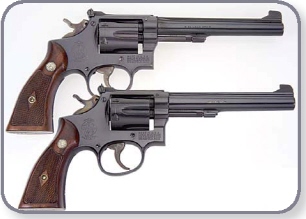
K-32, heavy barrel and light barrel configurations, from Paul Goodwin photos.
K-32 1st Model, “Fine…95%” - $3,163 – James D. Julia Auction, March 2003.
K-32 Hand Ejector (Postwar)
K-32 Masterpiece – “Pre-Model 16”
Caliber: .32 S&W Long. Double-action revolver built on the square butt K target frame with five screws, short cocking action, anti-backlash trigger, 6-groove tangs and serrated trigger; 1/8” or 1/10” Patridge front sights were cataloged, now fitted with the micrometer click rear sight. Narrow ribbed 6” barrel, checkered walnut stocks with S&W monograms. A large S&W trademark is found on the sideplate. Quite a scarce gun, with serial number ranges hard to pin down. Known serial numbers include all of K58921 through K58970 and K67601 – 67670, along with some of the guns in K767574 - K767599 and K68470 - K68530 ranges. All of these have the narrow rib. In 1950, the wide rib was introduced, and some K-32s from 1956 will be found in the K271792 - K271836 serial number range. Additional known serial number ranges listed under Model 16. Weight 38.5 oz. Manufactured c. 1946 – 1974.

AUCTION BLOCK
Two K-32s, one “very good as professionally refurbished” - $1,955; the other “excellent…98%” – $3,162 - Rock Island Auction, April 2006.
PRICE CHECK
Pre-16, gold box, “95%”, listed at $2,150 – David Carroll, 2006.
Pre-16, “excellent plus…98-99%,” listed at $1,975 – ArmchairGunShow.com, 2005.
Variations
• Limited run of 4" barrels in 1949 have been reported as a K-32 Combat Masterpiece; may bring four to five times regular value.
• It’s been reported that a 5" barrel variation may exist, but it has not been observed.
• Note: Unlike most models, the gold cardboard box for the K-32 is far more common than the gun, and it is easier to find a box than a gun. Accordingly, there is not much of a premium for the box.
Production Changes
• 1949: Introduced heavy barrel to Match the K-17 and K-38 in weight.
• 1952: Delete 1/10” Patridge front sight from catalog.
• 1955: Delete upper sideplate screw.
• 1957: K-32 Masterpiece continued as the Model 16 (see next section).
.32 Military & Police
Caliber: .32 S&W Long. Double-action revolver built on the square butt K frame with five screws; 2”, 4” barrel lengths are found and approximately 910 with a 5” barrel are reported. This model comprises a small group of M&P revolvers built to fire the .32 Long rather than the .38 and built on the larger .38 M&P K frame. Fixed sights with round blade front and square notch rear. 6-shot cylinder with a nominal length of 1.56”. “Smith &Wesson 32 Long CTG” on the barrel’s left side, with the right side blank. “Made in U.S.A.” on the frame next to the trigger guard. Large S&W monogram on the sideplate. .240” serrated trigger and checked hammer spur. Serial prefixes of “S” and “C” are found mixed in the 38 M&P series with 4,813 manufactured c. 1948 - 1950.

Variations
• Between 10 and 11 are reported to have been manufactured in 1949 with a micrometer click rear sight and a ramp front sight with 4" barrel. See also previous model variations.
.32-20 CALIBER
Target Models: All 32-20 Hand Ejector Models were standard issue with fixed sights. When one of these is found with factory original adjustable target sights it will bring a premium. This will range from 25 to 50% in the lower grades, to triple, quadruple or more in the higher grades.
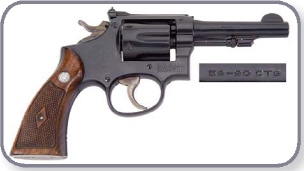
Scarce .32-20 Target configuration. David Nowak Collection, Paul Goodwin photo.
Caution: Do not use modern ammunition designated for rifles in these handguns!
.32-20 Hand Ejector
– 1st Model
Caliber: .32-20 Winchester. Double-action revolver built on the round butt K frame with four screws. 4”, 5”, 6” or 6-1/2” round pinned barrel lengths, 6-shot fluted cylinder with a nominal length of 1.56”, blue or nickel finish. This first model has no locking lug under the barrel. Checkered hard rubber grips with S&W monogram or walnut without the monogram. Fixed sights were a round front blade sight with square notched rear; target sights were a square cut blade mounted and pinned in a raised boss with an adjustable rear mounted in the top strap. The S&W trademark is stamped on the sideplate. Barrel markings of “32 Winchester CTG” on the left side. Smooth trigger with checked hammer spur. This model also has a spring loaded pin in the yoke (yoke stop) to assist in holding open the cylinder (not normally visible except by removing the yoke). Serial number range 1 - 5311 with all 5,311 manufactured c. 1899 - 1902.

Variations
• Target model worth 50% to 100% premium.
.32-20 Hand Ejector Model 1902
(.32-20 Hand Ejector Second Model)
Caliber: .32-20 Winchester. Double-action revolver built on the round butt K frame with four screws. 4”, 5” or 6-1/2” round pinned barrel lengths, 6-shot fluted cylinder with a nominal length of 1.56”, blue or nickel finish. Similar in design to first model but made with a locking lug under the barrel and a knurled round extractor knob threaded to the rod. Serial number range 5312 - 9811 with 4,499 manufactured c. 1902 - 1905.

Variations
• Target model worth 50 - 100% premium.
.32-20 Hand Ejector Model 1902 –
1st Change
Caliber: .32-20 Winchester. Double-action revolver built on a round or square butt K frame with four screws. 4”, 5” or 6-1/2” round pinned barrel lengths, 6-shot fluted cylinder with a nominal length of 1.56”. Similar to the Second Model with a slightly larger barrel diameter and frame front where the barrel threads in. Slight changes were also made in the yoke cut. Square butt target versions were manufactured in late 1904; otherwise a round butt frame with hard rubber or walnut grips, square butt with checkered walnut only. Blue or nickel finish. Serial number range 9812 - 18125 with 8,313 manufactured c. 1903 - 1905.

Variations
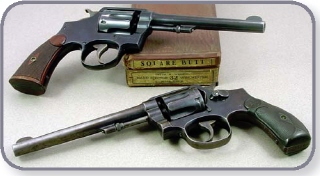
.32-20 Hand Ejectors. Old Town Station photo.
• Target model worth 50 - 100% premium.
.32-20 Hand Ejector Model 1905
(.32-20 Hand Ejector Third Model)
Caliber: .32-20 Winchester. Double-action revolver built on a round or square butt K frame with five screws, 4”, 5” or 6-1/2” round pinned barrel, 6-shot fluted cylinder with a nominal length of 1.56”. Very similar to preceding model with many internal changes including the addition of the trigger guard screw to become the first five-screw frame model in .32-20 caliber. Identical to the 38 M&P model of 1905 except for caliber; target versions were square butt only. Serial number range 18126 -22426 with 4,300 manufactured c. 1905 - 1906.

Variations
• Target model worth 50 - 100% premium.
.32-20 Hand Ejector Model of 1905
– 1st Change
Caliber: .32-20 Winchester. Double-action revolver built on a round or square butt K frame with five screws, 4”, 5”, 6” or 6-1/2” round pinned barrel; 6 -shot fluted cylinder with a nominal length of 1.56”. Similar in external appearance to the previous model but with various internal changes, this model incorporated a rebound slide, the date of the introduction of which is not exactly known. Round butt frame for fixed sight versions or square butt frame for target variations. Blue or nickel finish. Serial number range 22427 - c. 33500 with nearly 11,073 manufactured c. 1906 - 1909, overlapping with the 1905, 2nd Change Model.

Variations
• Target model worth 50 - 100% premium.
.32-20 Hand Ejector Model of 1905
– 2nd Change
Caliber: .32-20 Winchester. Double-action revolver built on a round or square butt K frame with five screws; 4”, 5”, 6” or 6-1/2” round pinned barrel lengths, 6-shot fluted cylinder with a length of 1.56”. Similar to preceding model with various internal changes including the addition of two dowel guide pins on the star extractor. Round or square butt frame for fixed sight versions or square butt frame with checked diamond walnut stocks for the target sight variations. Serial number range 33501 - 45200 with 11,699 manufactured c. 1906 - 1909, overlapping with 1905, 1st Change Model.

Variations
• Target model worth 50 - 100% premium.
.32-20 Hand Ejector Model of 1905
– 3rd Change
Caliber: .32-20 Winchester. Double-action revolver built on a round or square butt K frame with five screws; 4” or 6” round pinned barrel lengths, 6-shot fluted cylinder with a nominal length of 1.56”. Similar to 2nd change model with various internal changes including a longer double action throw. Patent dates were removed from the side of the barrels. Round or square butt frame for fixed sight versions and square butt frame only for target variations. Serial number range 45201 - 65700 with 20,499 manufactured c. 1909 - 1915.

Variations
• Target model worth 50 - 100% premium.
.32-20 Hand Ejector Model of 1905
– 4th Change
Caliber: .32-20 Winchester. Double-action revolver built on the square butt K frame with five screws; 4”, 5” or 6” round pinned barrel lengths, blue or nickel finish, forged round blade front sight, with a flattened top strap with a square notch cut rear sight for service sights. Target sights consisted of a square cut blade mounted and pinned in a raised boss with an adjustable rear mounted in the top strap. Target models have serrated front and rear tangs with six grooves and were only available with a square butt frame with a 6” barrel, beginning in 1923. Checked black hard rubber or checked diamond walnut stocks without medallions, 6-shot fluted cylinder with a nominal length of 1.56”. Serial numbers found on the butt, cylinder face, behind the star extractor, on the yoke and on the barrel flat. Heat treated cylinders began at serial number 81287. Barrel markings of “32 W.C.F. CTG” on the right side, “Smith & Wesson” on the barrel’s left side are observed. Has a smooth trigger with .265” checked hammer spur with smooth backstrap and forestrap on service model. Weight is 30 oz. with a 4” barrel. The S&W trademark is found on the frame’s left side with no other observed markings on the frame on our examples. Serial number range 65701 -144684 with 78,983 manufactured c. 1915 - 1940.

Variations
• Target model worth 50 – 100% premium.
Note: S&W handguns chambered in .32-20 were discontinued prior to WWII and have never resumed.
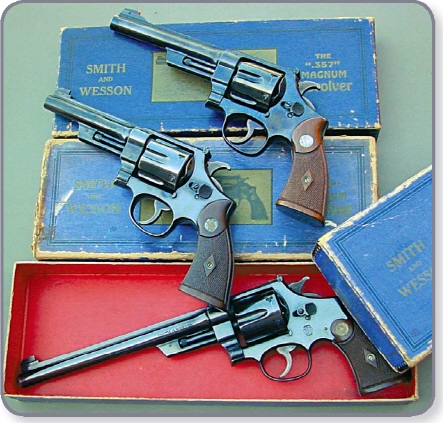
Registered Magnums. ArmsBid.com photo.
.357 MAGNUM CALIBER
N FRAME .357
The .357 Magnum
by Ray A. Cheely
The introduction of the .357 Magnum in 1935 was a profound event for the handgun world and Smith & Wesson. At the time, it was the most powerful handgun ever produced. Law enforcement, hunters and sportsmen all took note of previously unheard-of performance levels. It was the beginning of the age of magnum handguns.
During the late 1920s, there were calls for the development of something more potent than this venerable .38 Special, particularly from law enforcement personnel. Smith & Wesson responded with the large frame .38/44 Heavy Duty in 1930 and .38/44 Outdoorsman in 1931. Both were capable of firing hotter loads of .38 Special, but still fell short of expectations. Colonel Douglas B. Wesson, grandson of S&W co-founder Daniel B. Wesson, worked in conjunction with such noted hand loading experts as Phil Sharpe and Elmer Keith on the development of a revolver cartridge that would travel over 1400 fps. and deliver over 700 ft./lbs.of muzzle energy. The result was the .357 Magnum cartridge and the introduction of the Smith & Wesson .357 Magnum revolver.
S&W Initially offered the .357 Magnum only on a custom order basis, with the purchaser specifying sights, barrel length, finish and grips of his choosing. Later options included humpbacked hammer, Magna stocks and engraving. Each new gun was delivered with a numbered registration card and return envelope that would allow the owner to obtain a registration certificate bearing his name and specifications of the gun. Only about half of the guns produced resulted in requests for certificates.
Related items which could have come with these guns – such as the registration certificate, shipping tube for registration certificate, screwdriver, brochures and paper, spare sight blade in envelope, grip adapter and registration card with envelope – are all of considerable value, particularly when matched with the appropriate gun.
Most serious gun collecting is based on the concept of finding variations of a basic model. Due to the rich assortment of options available, one rarely finds two identical prewar .357 magnums! Options included:
• 23 different barrel lengths.
• Six main sight choices plus any King sight combination (dozens of additional choices).
• Blue, nickel and engraved finishes.
• Standard or magna grips.
• Optional humpbacked hammer.
• Optional grip adapter.
• Several other non-cataloged sight and grip variations.
This incredible assortment of possible combinations means that a collector’s quest for prewar .357 variations will never end. Authors’ Note: Any prewar magnum collector’s wife will quickly verify (and bemoan) the accuracy of this statement.
Smith & Wesson initially believed that virtually all .357 Magnum sales would be in the 8-3/4” variation. Accordingly, all early boxes (through Reg. No. 700-800?) are of the largest size (15-1/4” X 5-1/4”) bearing a picture of the gun with standard stocks and a grip adaptor. These early boxes, usually referred to as “Type I,” were printed with a darker blue ink than later variations. With the addition of Magna grips, subsequent boxes (Type II) carried the picture of the gun equipped accordingly. They appeared in three sizes (dimensions approximate):
Large 15-1/4” X 5-1/4”
Medium 13” X 4-7/8”
Small 11-5/8” X 4-3/8”
Registered Magnum boxes had a small white label on the bottom of the box that indicated the serial number and registration number. On non-Registered Magnum boxes this label indicated the serial number and usually the barrel length. In most instances, this label is missing or unreadable. Better condition boxes can easily bring $1000.
Early Test Guns
A few prototypes or “club” guns bearing “0” numbers were assembled in 1934 and 1935. These were given to VIPs for evaluation. Numbers 0372 and 0373 were given to Col. Douglas Wesson for use in his well-documented big game handgun hunts in 1935. Serial number 45808, with no registration number, was sent to the Springfield Armory for testing in early 1935. It was soon returned and given to Frank Baughman (close friend of J. Edgar Hoover and inventor of the Baughman front sight) at the FBI.
First Production
• Registration #1 was delivered to J. Edgar Hoover on April 17, 1935 (current whereabouts of this gun is unknown; it was not in his estate at the time of his death in 1974).
• Registration #2 was delivered to Philip B. Sharpe on April 17, 1935 (Phil Sharpe was a noted handloading expert and is credited for doing significant developmental work on the .357 Magnum).
• Registration #6 was delivered to Emil Hurja on May 7, 1935 (Emil Hurja was communications director and political pollster in the Franklin D. Roosevelt administration).
• Other prominent individuals receiving low registration numbers include Ed McGivern; Charles Hopkins of Western Cartridge Co.; John M. Olin of Western Cartridge Co.; Sasha A. Siemel, big game hunter; Major W. E. Witzel of Remington; and General George S. Patton.
The .357 Registered Magnum
Caliber: .357 Magnum. Registration numbers were stamped on the yoke cut preceded by “Reg” thus “Reg XXXX.” This was the first S&W revolver to use a counterbored cylinder to protect the cartridge rim. All frames are target with pinned barrel and extractor shroud. The barrel rib is checkered, with finely checkered topstrap and serrated backstrap and forestrap. “S&W .357 Magnum” is on the barrel’s right side. Early specimens have a small trademark on the left side, while later guns have a large trademark on the right side. Available with blue or nickel finish, target frame with serrated backstrap and forestrap, checkered diamond walnut on square butt grips or Magna type with an S&W monogram. This model has a spring-loaded locking ball bearing in the yoke to assist in locking open the cylinder. The cylinder is a 6-shot fluted with a nominal length of 1.62”. Other features include a finely checkered topstrap, checked barrel rib and .400” checked hammer spur, and a .265” grooved or .312” serrated trigger. “S&W .357 Magnum” is marked on the barrel’s right side. Numbered in the .44 Hand Ejector 3rd model series. Serial number range 45768 - 62489 (another source reports end of serial number range for Registered Magnums as lower than this). About 5,224 manufactured c. 1935 - 1939.
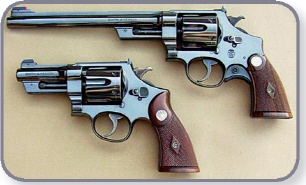
Registered .357 Magnums with the longest (8-3/4”) and shortest (3-1/2”) barrel lengths. Ray Cheely photo.

Note: In the last few years, realized prices of prewar magnums have risen dramatically, and this trend shows no sign of slacking. At this writing, Registered Magnums and related guns may be the hottest S&W collecting field. The combination of the strong historical significance and the incredible assortment of variations has made these guns highly desirable acquisitions for collectors. The prices above reflect an average of sales of guns with limited or no special features. A large number of these guns do have one or more special attractions in the form of registration certificate, shipment to a famous individual, law enforcement use, special sights, special finish or an original box with some of the accessories listed above. These guns will bring premium prices significantly in excess of those stated.
Variations
• Add $1000 to $1500 for original registration certificate accompanying gun. Forgeries known: CAUTION.
• Premium for certificate shipping tube.
• In general, Registered Magnum boxes and accessories are highly sought-after and will bring significant premiums.
• Barrel Lengths: In order of production quantities: 6-1/2", 5", 6", 8-3/4", 3-1/2", and 4". Other lengths bring premium prices, particularly 1/4" variations, which may bring multiples of standard value. Combination of rare barrel length and other rare features may bring a multiple of what a comparable-condition, more common configuration would bring. Among the more common barrel lengths, some collectors report that the shorter barrels enjoy some popularity and may bring a small premium.
• Nickel finish brings premium prices, perhaps double; probably fewer than 200 were manufactured.
• 4” barreled versions were shipped to Kansas City Police.
• Humpbacked hammer: Introduced in 1937; approximately 25% had this option.
• Special features worth premiums: Original factory pearl, ivory, or stag grips. Factory inscribed (47 made). Full factory engraving (11 made).
• One gun was custom made in .22 Long Rifle caliber, 8-3/8" with registration number 1591.
• It is reported that two were made with detachable shoulder stock for the U.S. Government.
• Fifteen were shipped to Postal Service in 1935. Another source notes that these may have been purchased through the Army and puts the date at 1938. See discussion in Pate.
• Registered Magnum # 506 attributed to General George S. Patton, Jr.
• Serial number 47769 with registration number 897 attributed to General George Van Orden.
• Serial number 57042 with registration number 4365 attributed to City of Cincinnati. Jan-24-1939.
• Serial number 53325 with registration number 2801 attributed to Springfield Armory NHS.
• It is reported that 15 were shipped to the City of Indianapolis Police Dept. Reported example with registration number #4862 is nickel with 5” barrel and humpback hammer. The others are believed to have adjacent registration numbers.
AUCTION BLOCK
• Registration number 4444, rare 8-3/8" barrel, excellent-plus condition - $12,100 – Kull & Supica Firearms Auction, April 2006.
• Several Registered Magnums - “Excellent 95%” - $3,450. “Excellent, over 95%” - $4,887. “Excellent, over 90%” - $3,162. “Excellent, over 99%” - $2,875. – all at Rock Island Auction, April 2006.
• Two Registered Magnums – one “93%” - $2,760; the other “98%” possible factory refinish, $2,875 – Amoskeag Auction, Sept. 2005.
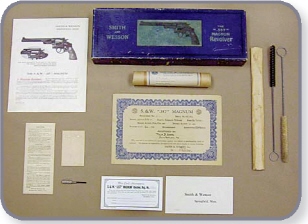
Various Registered .357 Magnum related items:
informational brochure with order form; type I box; certificate mailing tube; registration certificate; cleaning brush, swab and paper sleeve; multilingual caution note; envelope for sight blade; sight adjustment tool; and registration certificate request card and envelope. Ray Cheely photo.
• Three Registered Magnums, all in boxes – one 5”, “about excellent…97%” - $2,750; one 8.75”, “excellent…98%” - $3,300; and one 6” “about as new in box” - $5,500 – Supica’s Old Town Station, Oct. 2003.
• Registered Magnum, “Extremely fine…98%” - $2,703 – James D. Julia Auction, March 2003.
PRICE CHECK
Seven Registered Magnums listed for sale – “98%”, w/ box, $6,500; “97-98%” with factory gold inlaid inscription and history, $9,350; “98%” $6,450; 90% $3,150; 90% $3,150; 98.5 - 99% with box, $7,750; and KCMO police 65 - 75% 1,950. – David Carroll, 2006.
Three Registered Magnums listed for sale – “93-95%” $4,850; experimental test gun “96-97%” $5,750; Springfield Armory shipped $8,750 – Old Town Station Dispatch, 2005-2006.
Note: A considerable number of the guns produced toward the end of the run of Registered Magnums had registration numbers stamped in the yoke cut but were not recorded as Registered Magnums in the factory records. Apparently, there was little interest in the “registration” process at this time. These guns would be considered as non-Registered Magnums (see next listing).
Prewar .357 Magnum Non-Registered
These guns are the same as above except that they have no registration number stamped in the yoke cut and barrel lengths were standardized as 3-1/2”, 5”, 6”, 6-1/2”, and 8-3/8”. These are even more rare than Registered Magnum models, with only about 1400 produced. In general, they were more likely to be heavily used than the Registereds, and accordingly high condition guns are notably scarce. Boxes are the same as used with Registered Magnums c. 1935 - 1941.

Variations
• Non-standard barrel lengths and non-standard sights command very substantial premiums.
• Nickel finish is extremely rare and will bring a very substantial premium.
• The last Non-Registered Magnum and the only wartime production Magnum was produced in 1942 with a 4-1/2" barrel, small logo on the left side and a large logo on the right side, serial number 62489.
.357 Magnum Transitional Postwar
The first post-war magnum was produced December 5, 1946, with a total of 142 completed by the end of 1949. Postwar transitional guns were similar in appearance to prewar with the exception of the new micrometer click rear sight. An “S” was added as a prefix to the serial number. Apparently, most transitional magnums were ordered by police departments; thus longer barrel lengths are very scarce. There were perhaps six or fewer produced with barrel lengths of 8” or longer. Boxes are the same as used with prewar Registered Magnums until the factory began using gold boxes somewhere around 1947 - 1948.
Sales of transitional magnums occur so rarely that prices are difficult to determine. A high-condition specimen in any configuration would bring at least $8000 - $10,000. Other conditions would be at proportionate levels.
Noteworthy Examples
• Serial number S71655 with an 8-3/8" barrel was shipped to Remington Arms Company as a test gun.
• Serial number S71893 with an 8-3/8" barrel was given to President Harry S. Truman and is now located in the Truman Library. It is engraved “Col. Harry S. Truman.”
• Serial number S71972 with an 8-3/8" barrel was given to Major General Julian S. Hatcher at the NRA. It is engraved “Julian S. Hatcher.”
.357 Magnum
– “Pre-Model 27”
During 1950, at approximately serial number S75000, the .357 Magnum was modernized with the incorporation of the short-throw hammer. One source puts the first .357 Magnum short action as serial number S75514, c. Nov. 13, 1950. However, see conflicting information on that serial number at the listing for the .38/44 Heavy Duty Model of 1950. This model was offered with the choice of blue or nickel finish (rare), any standard target sights, checkered walnut stocks with S&W inlaid medallions (target stocks available about 1954 and thereafter), finely checkered topstrap with matching barrel rib and grooved forestrap and backstrap. Barrels were standardized at 3-1/2”, 5”, 6”, 6-1/2”, and 8-3/8” with the five-screw target N-frame. The “S” prefix was continued until 1969 when it was changed to “N.” The upper sideplate screw was eliminated in 1956 with serial numbers in the range of S172000. The 357 Magnum became the Model 27 in 1957.
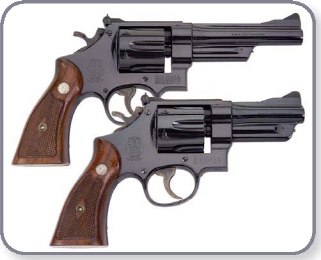
Pre-Model 27’s; 5” and 3-1/2” barrels. from Paul Goodwin photos.

AUCTION BLOCK
Factory A engraved Pre-27, “Excellent plus…over 98%” - $2,588 – Rock Island Auction, April 2006
Variations
• 3.5” barrel may bring 25% premium.
• Slight premium for nickel in higher condition grades.
AUCTION BLOCK
Nickel Pre-27, “excellent, 98-99%” - $2,255 – Kull & Supica Auction, April 2006.
Production Changes
• 1950: Begin “S” serial prefix c. serial number S75000.
• 1956: Delete upper sideplate screw c. serial number S172000.
• 1957: The .357 Magnum continued as the Model 27 (see next section).
The Highway Patrolman
– “Pre-Model 28”
Caliber: .357 Magnum/.38 Special. Introduced in April 15, 1954. Double-action revolver built on the square butt N target frame with five screws as the Highway Patrolman, a utility version of the pre-Model 27 with a satin blue finish. This model is the only N frame with an adjustable rear sight leaf that is non-serrated as well as having no serrations on the barrel rib. Six-shot fluted and counterbored cylinder with a nominal length of 1.62”. 4” or 6” pinned and ribbed barrel without serrations, Magna style or target walnut grips with S&W medallions and diamond around the screw escutcheon. This model has a 6-groove serrated backstrap and forestrap and “Highway Patrol” stamped on the barrel, 1/8” Baughman Quick Draw front sight with adjustable micrometer click rear sight, shrouded extractor rod, .400” semi-target hammer, .265” serrated trigger or .400” smooth trigger. Original test production marked “PATROLMAN.” The name change was suggested by Mrs. Florence Van Orden of The Evaluators Ltd. to then-president Carl Hellstrom. 8,427 manufactured in the first year of production. Produced c. 1954 – 1986.
Production Changes
• 1954: Begin “S” serial prefix at S103500; 8,427 manufactured in 1954.
• 1956: Delete the upper sideplate screw at approximately S171584.
• 1957: Highway Patrolman continued as the Model 28 (see next section).
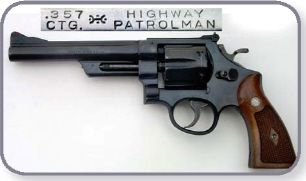
Highway Patrolman. Old Town Station photo.

K FRAME .357
Well-known border patrolman, writer and exhibition shooter Bill Jordan, among others, urged S&W to offer the power of the .357 cartridge in a more compact package than the big N frame. The result was the K frame “.357 Combat Magnum,” which was introduced in 1955 and continued as the Model 19.
The .357 Combat Magnum
– “Pre-Model 19”
Caliber: .357 Magnum. Double-action revolver built on the square butt, four-screw K target frame that is slightly larger than a standard K frame in the yoke area. Available in blue or nickel finish and originally available in 4” barrel length only with a 1/8” Baughman Quick Draw on plain ramp base front sight with an adjustable micrometer click rear sight. 6-shot fluted and counterbored cylinder with a nominal length of 1.67”. Manufactured c. 1955 – 1999.

Variation
• Initial production was shipped in dark blue presentation cases, marked “COMBAT MAGNUM” on top.
Production Changes
• 1955: Introduction at serial number K260001.
• 1957: The .357 Combat Magnum continued as the Model 19 until 1999 (see next section).